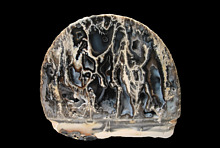Home PageAbout MindatThe Mindat ManualHistory of MindatCopyright StatusWho We AreContact UsAdvertise on Mindat
Donate to MindatCorporate SponsorshipSponsor a PageSponsored PagesMindat AdvertisersAdvertise on Mindat
Learning CenterWhat is a mineral?The most common minerals on earthInformation for EducatorsMindat ArticlesThe ElementsThe Rock H. Currier Digital LibraryGeologic Time
Minerals by PropertiesMinerals by ChemistryAdvanced Locality SearchRandom MineralRandom LocalitySearch by minIDLocalities Near MeSearch ArticlesSearch GlossaryMore Search Options
The Mindat ManualAdd a New PhotoRate PhotosLocality Edit ReportCoordinate Completion ReportAdd Glossary Item
Mining CompaniesStatisticsUsersMineral MuseumsClubs & OrganizationsMineral Shows & EventsThe Mindat DirectoryDevice SettingsThe Mineral Quiz
Photo SearchPhoto GalleriesSearch by ColorNew Photos TodayNew Photos YesterdayMembers' Photo GalleriesPast Photo of the Day GalleryPhotography
╳Discussions
💬 Home🔎 Search📅 LatestGroups
EducationOpen discussion area.Fakes & FraudsOpen discussion area.Field CollectingOpen discussion area.FossilsOpen discussion area.Gems and GemologyOpen discussion area.GeneralOpen discussion area.How to ContributeOpen discussion area.Identity HelpOpen discussion area.Improving Mindat.orgOpen discussion area.LocalitiesOpen discussion area.Lost and Stolen SpecimensOpen discussion area.MarketplaceOpen discussion area.MeteoritesOpen discussion area.Mindat ProductsOpen discussion area.Mineral ExchangesOpen discussion area.Mineral PhotographyOpen discussion area.Mineral ShowsOpen discussion area.Mineralogical ClassificationOpen discussion area.Mineralogy CourseOpen discussion area.MineralsOpen discussion area.Minerals and MuseumsOpen discussion area.PhotosOpen discussion area.Techniques for CollectorsOpen discussion area.The Rock H. Currier Digital LibraryOpen discussion area.UV MineralsOpen discussion area.Recent Images in Discussions
Mineralogical ClassificationIMA 2014-008 = wernerkrauseite
17th May 2016 13:50 UTCMarco E. Ciriotti Manager
▪ Galuskin, E.V., Krüger, B., Krüger, H., Blass, G., Widmer, R., Galuskina, I.O. (2016): Wernerkrauseite, CaFe3+2Mn4+O6 - the first non-stoichiometric post-spinel mineral, from Bellerberg volcano, Eifel, Germany. European Journal of Mineralogy, 28, 485-493.
Abstract:
Black prismatic crystals of the new mineral wernerkrauseite, ideally CaFe3+2Mn4+O6 [Pnma, a = 9.0548(2), b 2.8718(1), c = 10.9908(2) Å; V = 285.80(1) Å3, Z = 8/3], were found in altered xenoliths within alkaline basalts of the Bellerberg volcano, Eifel, Rhineland-Palatinate, Germany. Fluorellestadite, wadalite, andradite–schorlomite, perovskite, gehlenite, magnesioferrite, cuspidine, ettringite–thaumasite, hydrocalumite, jennite, katoite, and portlandite are the main associated minerals. Wernerkrauseite crystals up to 0.5 mm in size show strong submetallic lustre; the streak is black. Wernerkrauseite appears grey in reflected light. Pleochroism is very weak, bireflectance and anisotropy are weak. Reflectance data for the COM wavelengths vary from ∼31 % (400 nm) to ∼19 % (700 nm). The calculated density is 4.66 g/cm3, microhardness VHN25 is 154(5) kg/mm2. Wernerkrauseite is a Ca-deficient structural analogue of harmunite, CaFe2O4, and therefore is one of the four known minerals with post-spinel structures. The empirical chemical formula of the holotype wernerkrauseite is Ca0.994(Fe3+ 1.057Mn4+ 1.025 Mn3+ 0.878Mg0.030Al0.016)Σ3.006O6. The end-member chemical formula can also be given on the basis of spinel stoichoimetry (Z = 4): Ca2/3[Fe3+4/3Mn4+2/3]O4, which better reflects its non-stoichiometry. The crystal structure was determined using single-crystal Xray diffraction (R1 = 0.0233 for 800 observed reflections [I>2σ(I)]). The diffraction pattern shows evidence of short-range ordering of Ca-vacancies. The strongest diffraction lines of the calculated powder diffraction pattern are [dhkl (I)]: 2.646 (100), 2.450 (77), 2.748 (62), 4.527 (54), 4.698 (44), 1.818 (43), 2.425 (37), 1.778 (30). Raman spectra of wernerkrauseite were measured and analysed in comparison to the spectra of harmunite and marokite, CaMn2O4. Crystallisation of wernerkrauseite took place at temperatures below 850–900°C under high oxygen fugacity. Furthermore, Mn4+-bearing non-stoichiometric harmunite Ca0.862(Fe3+1.719 Mn4+0.265Ti4+ 0.012Mg0.008)Σ2.004O4 was found at the same locality, which suggests the existence of a continuous solid solution between wernerkrauseite, harmunite and Ca2/3Mn3+4/3Mn4+2/3O4, described by the formula Ca1-x/2(Fe3+,Mn3+)2-xMn4+xO4, with × ranging from 0 to 2/3.

17th May 2016 14:34 UTCKnut Edvard Larsen 🌟 Manager

18th May 2016 09:54 UTCGuenter Blass
unfortunately I refer not EJM.
Please, would you send me a PDF.
ciao
Günter
19th May 2016 05:18 UTCMarco E. Ciriotti Manager
Ciao.




Mindat.org is an outreach project of the Hudson Institute of Mineralogy, a 501(c)(3) not-for-profit organization.
Copyright © mindat.org and the Hudson Institute of Mineralogy 1993-2024, except where stated. Most political location boundaries are © OpenStreetMap contributors. Mindat.org relies on the contributions of thousands of members and supporters. Founded in 2000 by Jolyon Ralph.
Privacy Policy - Terms & Conditions - Contact Us / DMCA issues - Report a bug/vulnerability Current server date and time: April 25, 2024 06:53:21
Copyright © mindat.org and the Hudson Institute of Mineralogy 1993-2024, except where stated. Most political location boundaries are © OpenStreetMap contributors. Mindat.org relies on the contributions of thousands of members and supporters. Founded in 2000 by Jolyon Ralph.
Privacy Policy - Terms & Conditions - Contact Us / DMCA issues - Report a bug/vulnerability Current server date and time: April 25, 2024 06:53:21










